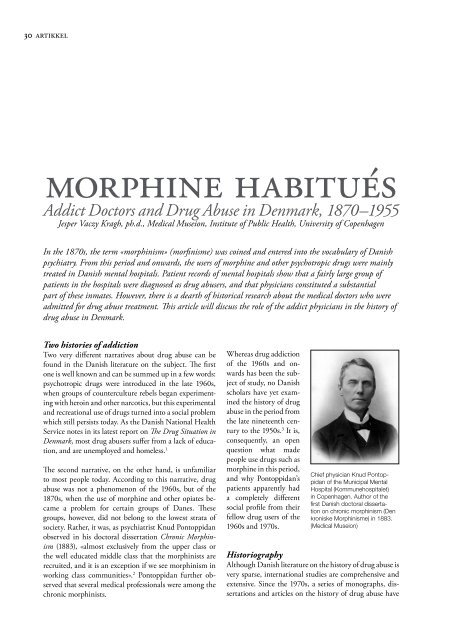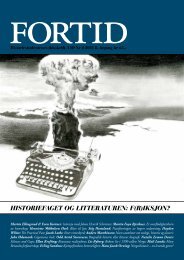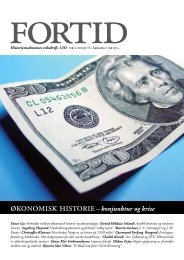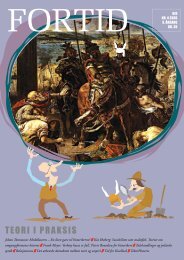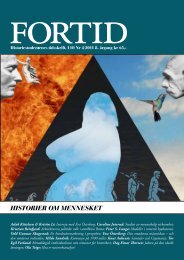You also want an ePaper? Increase the reach of your titles
YUMPU automatically turns print PDFs into web optimized ePapers that Google loves.
30 artikkel<br />
morphine habitués<br />
Addict Doctors and Drug Abuse in Denmark, 1870–1955<br />
Jesper Vaczy Kragh, ph.d., Medical Museion, Institute of Public Health, University of Copenhagen<br />
In the 1870s, the term «morphinism» (morfinisme) was coined and entered into the vocabulary of Danish<br />
psychiatry. From this period and onwards, the users of morphine and other psychotropic drugs were mainly<br />
treated in Danish mental hospitals. Patient records of mental hospitals show that a fairly large group of<br />
patients in the hospitals were diagnosed as drug abusers, and that physicians constituted a substantial<br />
part of these inmates. However, there is a dearth of historical research about the medical doctors who were<br />
admitted for drug abuse treatment. This article will discuss the role of the addict physicians in the history of<br />
drug abuse in Denmark.<br />
Two histories of addiction<br />
Two very different narratives about drug abuse can be<br />
found in the Danish literature on the subject. The first<br />
one is well known and can be summed up in a few words:<br />
psychotropic drugs were introduced in the late 1960s,<br />
when groups of counterculture rebels began experimenting<br />
with heroin and other narcotics, but this experimental<br />
and recreational use of drugs turned into a social problem<br />
which still persists today. As the Danish National Health<br />
Service notes in its latest report on The Drug Situation in<br />
Denmark, most drug abusers suffer from a lack of education,<br />
and are unemployed and homeless. 1<br />
The second narrative, on the other hand, is unfamiliar<br />
to most people today. According to this narrative, drug<br />
abuse was not a phenomenon of the 1960s, but of the<br />
1870s, when the use of morphine and other opiates became<br />
a problem for certain groups of Danes. These<br />
groups, however, did not belong to the lowest strata of<br />
society. Rather, it was, as psychiatrist Knud Pontoppidan<br />
observed in his doctoral dissertation Chronic Morphinism<br />
(1883), «almost exclusively from the upper class or<br />
the well educated middle class that the morphinists are<br />
recruited, and it is an exception if we see morphinism in<br />
working class communities». 2 Pontoppidan further observed<br />
that several medical professionals were among the<br />
chronic morphinists.<br />
Whereas drug addiction<br />
of the 1960s and onwards<br />
has been the subject<br />
of study, no Danish<br />
scholars have yet examined<br />
the history of drug<br />
abuse in the period from<br />
the late nineteenth century<br />
to the 1950s. 3 It is,<br />
consequently, an open<br />
question what made<br />
people use drugs such as<br />
morphine in this period,<br />
and why Pontoppidan’s<br />
patients apparently had<br />
a completely different<br />
social profile from their<br />
fellow drug users of the<br />
1960s and 1970s.<br />
Chief physician Knud Pontoppidan<br />
of the Municipal Mental<br />
Hospital (Kommunehospitalet)<br />
in Copenhagen. Author of the<br />
first Danish doctoral dissertation<br />
on chronic morphinism (Den<br />
kroniske Morphinisme) in 1883.<br />
(Medical Museion)<br />
Histori<strong>og</strong>raphy<br />
Although Danish literature on the history of drug abuse is<br />
very sparse, international studies are comprehensive and<br />
extensive. Since the 1970s, a series of mon<strong>og</strong>raphs, dissertations<br />
and articles on the history of drug abuse have


